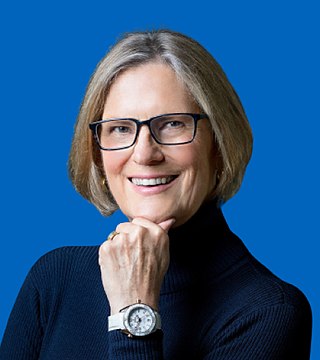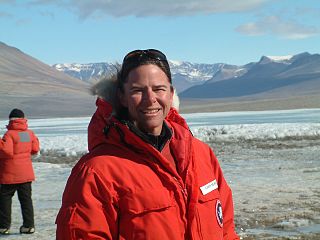Related Research Articles

Kathryn Dwyer Sullivan is an American geologist, oceanographer, and former NASA astronaut and US Navy officer. She was a crew member on three Space Shuttle missions.
The Nevada System of Higher Education is a state government unit in Nevada that oversees its public system of colleges and universities. It was formed in 1968 to oversee all state-supported higher education in the state. Two doctoral-granting research universities, two state colleges, three community colleges and one research institute comprise the land grant system. About 105,000 students attend the degree-granting campuses.
Desert Research Institute (DRI) is the nonprofit research campus of the Nevada System of Higher Education (NSHE) and sister property of the University of Nevada, Reno (UNR), the organization that oversees all publicly supported higher education in the U.S. state of Nevada. At DRI, approximately 500 research faculty and support staff engage in more than $50 million in environmental research each year. DRI's environmental research programs are divided into three core divisions and two interdisciplinary centers. Established in 1988 and sponsored by AT&T, the institute's Nevada Medal awards "outstanding achievement in science and engineering".

The American Geophysical Union (AGU) is a 501(c)(3) nonprofit organization of Earth, atmospheric, ocean, hydrologic, space, and planetary scientists and enthusiasts that according to their website includes 130,000 people. AGU's activities are focused on the organization and dissemination of scientific information in the interdisciplinary and international fields within the Earth and space sciences. The geophysical sciences involve four fundamental areas: atmospheric and ocean sciences; solid-Earth sciences; hydrologic sciences; and space sciences. The organization's headquarters is located on Florida Avenue in Washington, D.C.

The Perkin Medal is an award given annually by the Society of Chemical Industry to a scientist residing in America for an "innovation in applied chemistry resulting in outstanding commercial development." It is considered the highest honor given in the US chemical industry.
The IEEE Edison Medal is presented by the Institute of Electrical and Electronics Engineers (IEEE) "for a career of meritorious achievement in electrical science, electrical engineering, or the electrical arts." It is the oldest medal in this field of engineering. The award consists of a gold medal, bronze replica, certificate, and honorarium. The medal may only be awarded to a new leap/breakthrough in the technological area of science.
The Marjorie Barrick Museum of Art is a museum located on the main campus of the University of Nevada, Las Vegas (UNLV), established in 1967. The museum was originally instituted as a natural history museum with a focus on the natural history and environment of Nevada and the broader Southwestern United States. In December 2011, the Barrick joined the UNLV College of Fine Arts and became the anchor of the Galleries at UNLV. The six galleries and one museum that make up the Galleries are each entities in their own right linked via a common administration.
John Hersh Seinfeld is an American chemical engineer and pioneering expert in atmospheric science. His research on air pollution has influenced public policy, and he developed the first mathematical model of air quality, which has influenced air pollution tracking and research across the United States. He has spent his career at the California Institute of Technology, where he is currently the Louis E. Nohl Professor of Chemical Engineering.

The American Institute of Chemists Gold Medal is the highest award of the American Institute of Chemists and has been awarded since 1926.
The Australian Institute of Physics was established in 1963, when it replaced the Australian Branch of the British Institute of Physics based in London. The purpose of the institute is to promote the role of physics in research, education, industry and the community. The AIP publishes Australian Physics since 1963. Every two years, the Institute organises a national congress, the latest being held in December 2022 in Adelaide.
James Vladimir Taranik was an American scientist and educator who worked in the area of earth-observation satellite remote sensing. He was Chief of NASA's Non-Renewable Resources Branch and Program Scientist of the Space Shuttle's first scientific flights with cargo that included experiments related to geology, atmospheric chemistry, meteorology, marine biology, and plant physiology in the earth and life sciences. He also held various positions in the Nevada System of Higher Education, including the Desert Research Institute and the Mackay School of Earth Sciences and Engineering.
The Chemical Industry Medal is an annual American award given to an industrial chemist by the Society of Chemical Industry America. The medal has been awarded since 1933, when it replaced the Grasselli Medal. It was initially given to "a person making a valuable application of chemical research to industry. Primary consideration shall be given to applications in the public interest." As of 1945, the criterion became "a person who ... has rendered conspicuous service to applied chemistry." More recently it has been awarded "for contributions toward the growth of the chemical industry."

Alison Murray is an American microbial ecologist and Antarctic researcher, best known for studying the diversity, ecology and biogeography of Antarctic marine plankton dynamics of the plankton over the annual cycle; and her work demonstrating the existence of microbial life within an ice-sealed Antarctic lake. She studies how microorganisms persist and function in extremely cold and harsh environments, including those that lack oxygen and biological sources of energy.
The National Institute of Social Sciences (NISS) is one of the oldest honorary societies in the United States. The stated mission of NISS is to promote the study of the social sciences, to support social science research and discussion, and to honor individuals who have rendered distinguished service to humanity.
Charles Remington Goldman is an American limnologist and ecologist.
Sex as a biological variable (SABV) is a research policy recognizing sex as an important variable to consider when designing studies and assessing results. Research including SABV has strengthened the rigor and reproducibility of findings. Public research institutions including the European Commission, Canadian Institutes of Health Research, and the U.S. National Institutes of Health have instituted SABV policies. Editorial policies were established by various scientific journals recognizing the importance and requiring research to consider SABV.
Albert Yu-Min Lin is an American engineer, scientist, technologist, explorer and television host. He is a senior lecturer and an associate research scientist of mechanical and aerospace engineering at University of California, San Diego. Since 2019 he has been the presenter of Lost Cities With Albert Lin.
References
- ↑ "About the DRI Nevada Medal". Desert Research Institute. Archived from the original on 13 December 2012. Retrieved 1 July 2012.
- ↑ "2020 DRI Nevada Medal of Science to honor Dr. Kathryn Sullivan, first American woman to walk in space" (Press release). 25 November 2019.